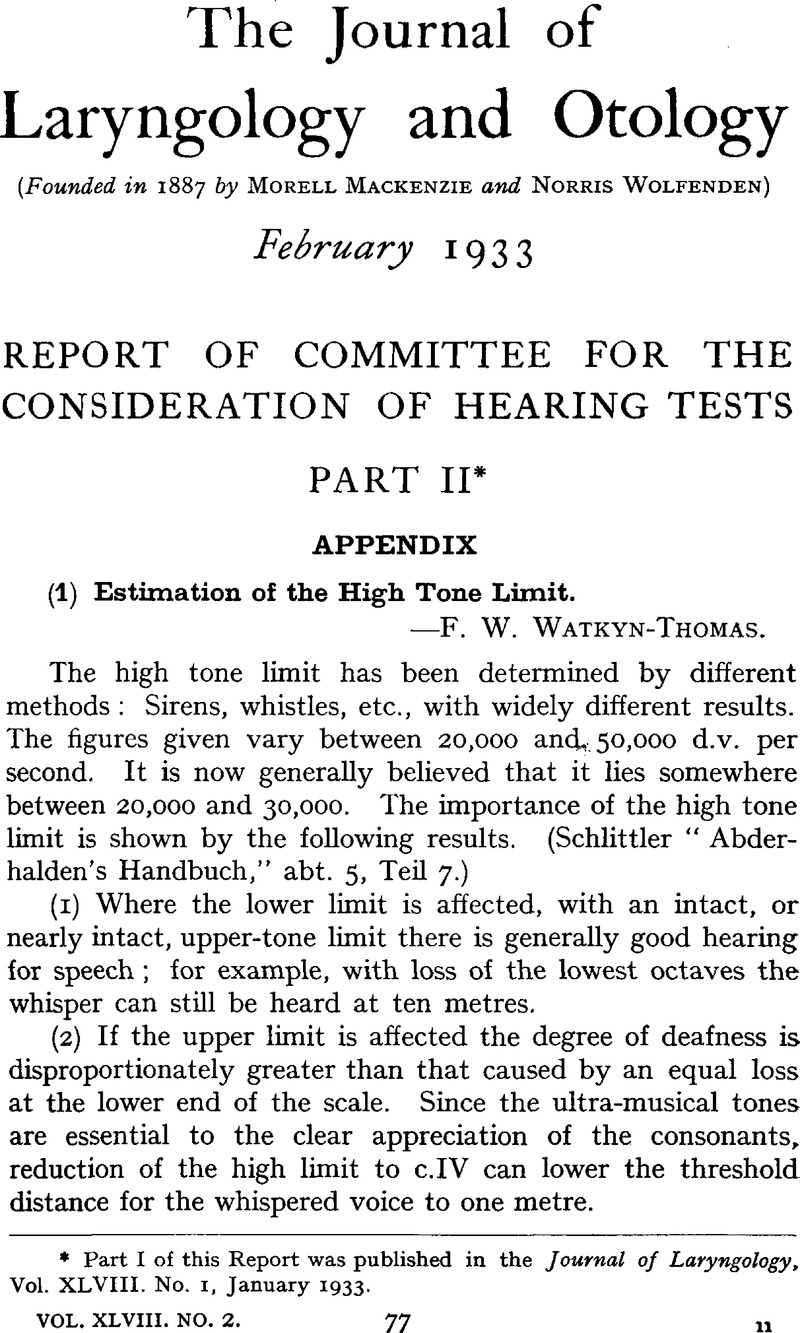No CrossRef data available.
Article contents
Report of Committee for the Consideration of Hearing Tests Part II*
Published online by Cambridge University Press: 06 August 2007
Abstract
An abstract is not available for this content so a preview has been provided. Please use the Get access link above for information on how to access this content.

- Type
- Research Article
- Information
- Copyright
- Copyright © JLO (1984) Limited 1933
References
Bansister, H., “Auditory Theory; Criticism of Professor Boring's Hypotheses,” Amer. Jour. Psychol., 1927, xxxviii., 436–40.CrossRefGoogle Scholar
Pohlman, A.C., “Theories of Sound Analysis and Intensity Control on Basis of Middle and Inner Ear Mechancis,” Ann. Otol. Rhin. and Laryng., 1927, xxxvi., 579–603;CrossRefGoogle Scholar
Pohlman, A.C., “Theories of Sound Analysis and Intensity Control on Basis of Middle and Inner Ear Mechancis,” Ann. Otol. Rhin. and Laryng., 1927, and xxxiii., 484–504.Google Scholar
Tastet, D.W., “Statistical Study of Relation between Appearance of Tympanic Memberane and Impairment of Auditory Function,” U.S. Vet. Bull., 1927, iii., 1039–49.Google Scholar
Macfarlane, D. “Distinguishing between Tactile Sense and Audition in Deaf Child,” Arch. Oto-laryng., 1927, v., 507–8.CrossRefGoogle Scholar
Sonnenschein, R., “Recent Literature on Cranial Resonance and ist Clinical Application,” Ann. Oto. Rhin., etc., 1927, xxxvi., 454–62.Google Scholar
Fowler, E. P. “Marked Deafness Areas in Normal Ears,” Arch. Oto-laryng., 1928, viii., 151–5.CrossRefGoogle Scholar
Emerson, F.P., “Mooted Points in Sound Conduction and Perception during Course of chronic progressive Deafness,” Laryngoscope, 1928, xxxviii., 185–96.CrossRefGoogle Scholar
Pattie, F. A. Jr., “An Experimental Study of Fatigue in the Auditory Mechansim,” Amer. Journ. Psychol., 19278, xxxviii., 39–58.Google Scholar
Flugel, J. C., “On Local Fatigue in the Auditory System,” Brit. Journ. Psychol., 1920–21, xi., 105–34.Google Scholar
Bartlett, F.C., and Mark, H., “A Note on Local Fatigue in the Auditory System,” Brit. Journ. Psychol. 1922–3, xiii., 215–8.Google Scholar
Wells, W. A. “The Influence of Sounds of Different Pitch, Duration and Intensity in the Production of Auditory Fatigue,” Laryngoscope, 1913, xxiii., 989–98.CrossRefGoogle Scholar
Bunch, C. C., “Auditory Acuity after Removal of entire Right Cerebral Hemisphere,” Journ. Amer. Med. Assoc., 1928, xc., 2102.CrossRefGoogle Scholar
Luciani, L., “Human Physiology,” Translated by Frances A. Welby, London, 1917, iv., 264–5.Google Scholar
Rich, , “A Preliminary Study of Tonal Volume,” Journ. of Exper. Psychol., 1916, i., 13.CrossRefGoogle Scholar
Watt, , “ Psychological Analysis and the Theory of Hearing,” Brit Journ. of Psychol., 1914, vii., 1.Google Scholar
Sonnenschein, R., “Rationale of Tuning-fork Tests, ” Ann. Otol. Rhin., etc., 1928, xxxvii., 309–28.CrossRefGoogle Scholar
Fowler, E. P., “Limitations in Differential Diagnosis of Deafness,” Trans, Amer.Laryng.Rhin., etc., 1927, xxxiii., 332–44.Google Scholar
Drury, D. W. and Gallivan, D. E., “Quality Hearing,” Ann. Otol. Rhin., etc., 1928 xxxvii., 661–74.CrossRefGoogle Scholar


